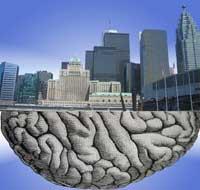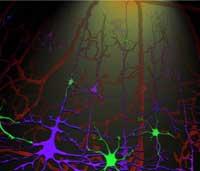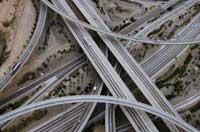Structure of cities in the brain
2009/11/28 Lakar Iraizoz, Oihane - Elhuyar Zientzia

At first glance, no one would say that cities and brains have anything in common. The first ones were created by us, the oldest cities known 5-15 thousand years ago. Cities are the place of residence of people, the place of residence of more or less large groups.
Meanwhile, the brains were born about 535 million years ago in different animals without any intervention. They control several functions of living beings: the senses, the movement, the behavior, the intelligence, the heartbeat and the body temperature, to name but a few.
Well, researchers at the Rensselaer Polytechnic Institute in the United States have found similarities between the two apparently disconnected. A study reveals that cities and brains have evolved similarly. Or more specifically the communication networks of each other.

More complex as it increases
The bigger they are, the more connections they have, both brains and cities. And, besides being more, they are more complex. Living beings in the brain need complex communication networks to make intelligence richer and more complex, and for cities to have large, productive populations on the roads. In both cases, the need to maintain a sufficient level of intercommunication for the proper functioning of the system.
As the researchers have pointed out, to create a human brain would not be enough the union of two canine brains. There would be no complex links and connections in the human brain, so this brain would not have the mental capacity we humans have.
The same goes for cities. In large cities it is necessary to have complex and efficient road networks to maintain the functionality of the city. Thus, as it increases, increasingly complex infrastructures are created: more variants, more highways around cities, more lanes on roads, more exits on highways, etc.
That is, as in the case of brains, it would not be enough to unite two small cities to get the communications network of a large city. The only difference in the organizational network of brains and cities is that, according to researchers, neurons transport information and highways and roads transport people and materials.
Pressure moulding

How is it possible that the evolution of cities is so similar to that of the brain? Well, researchers believe that the "driving force" behind them is similar. In nature, the regulator of evolution is called natural selection: changes in living beings appear and progress those that best adapt to the conditions of the environment.
Environmental conditions vary over time, so that animals gradually adapt and change. This is what has happened in the size and structure of the brains, and that is why every animal species has a brain of a certain size.
Natural selection has no influence on the evolution of cities. Those that directly affect cities are politicians and businessmen. Well, according to researchers, politics and economics have the same impact as natural selection on nature. In both cases the influence is not direct, but indirect or passive. And in both the same result has been obtained. There it is!
Published in Ortzadar

Gai honi buruzko eduki gehiago
Elhuyarrek garatutako teknologia






